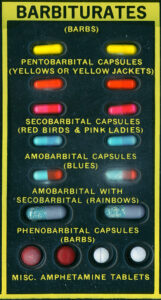Chapter 4: Depressants: Opiates, Opioids, and Sedatives
By the end of this chapter, you should be able to:
- Define the characteristics of the major classes of drugs. (LO2)
- Identify and summarize the addiction process and the characteristics thereof. (LO3)
Overview of Depressants
Depressants are substances that are meant to reduce a function of an organ or bodily system. Depressants typically decrease the functioning of the central nervous system in the same way that stimulants increase the functioning of the central nervous system (APA, 2022). For a review from Chapter 1, it may be beneficial to watch the short video on Depressants and Opiates (Khan Academy, 2014).
Opiates and Opioids
Opiates, are either naturally or synthetically derived from (APA, 2022). Opioids are the naturally occurring opiates (like morphine) and synthetic versions (like heroin). Users may experience positive effects, when used clinically as pain relievers, anesthesia, cough suppressants, and antidiarrheal drugs. But, as with all drugs we are discussing, opioids are prone to abuse and dependence in the long-term; symptoms include pain relief, fatigue, euphoria, respiratory depression, significant or serious constipation, and reduced function in the gastrointestinal system (APA, 2022; Bahmutsky, et al., 2020).
Review the maps below regarding opioid usage in 2009 (Butler, et al., 2011). Do you think that opioid usage has grown since this data was captured? What about the centers available for treatment? Opioid have been proven beneficial for those experiencing chronic pain among other issues, but the side effects like addiction or death come along with those benefits (Abdallah, et al., 2019; Nadeau, et al., 2021; Kakko, et al., 2019). Addiction is subjective and multi-faceted (Jones, et al., 2018), it will not be a simple fix or solution, more research and data are needed in many cases to develop better solutions for the future. After viewing the content below, it may be beneficial to review some data provided by the Centers for Disease Control and Prevention.
Move the bar to the right to see usage rates in 2009 and move the bar to the left to see treatment centers. Why is this important information to consider?
Sedatives
Sedatives are drugs that relax the user, reduces feelings of anxiety, agitation, or excitement by depressing the nervous system. How much relaxation, from easing tension to sleeping, depends on the drug, the dosage, how it is administered, and the users general status (APA, 2022). Sedatives were synthesized first in 1832 by Justus von Liebig, though it was not declared a hynotic sedative until 1869 by Oskar Liebreich (Lopez-Munoz, et al., 2005; Guina & Merrill, 2018). Since then, the drugs have been used extensively for everything from seizures or sleep medication. While they have proven to help in many ways, long term use can be toxic and harmful (Lopez-Munoz, et al. 2005). There are two sedatives that will be covered below: Barbiturates and Benzodiazepines.

Barbiturates
Barbiturates depress the functioning of the cerebellum, leading to sedation and drowsiness . Barbiturates are administered orally are through an injection. Infants, pregnant and geriatric persons should avoid using these drugs. There are some fairly extreme side effects related to taking this kind of drug including but not limited to (Wisconsin Technical College):
- Suicidal thoughts and behaviors (Carlsten & Waern, 2009)
- Gastrointestinal issues
- Rashes
- Respiratory depression
- Blood disorders (potentially fatal)
- Should not be used with alcohol (can cause death)
- Addictive
Benzodiazepines

Benzodiazepines are generally used to combat anxiety, seizures, and promote relaxation. Benzos that are injected are generally used for sedation while those that are consumed orally are to treat anxiety. They can also be used to treat generalized anxiety, panic disorder, withdrawal of other depressants (alcohol), and insomnia (APA, 2022; Sanabria, et al., 2021; Guina & Merrill, 2018). Much like barbiturates, children, pregnant, and elderly people should refrain from using these sort of drugs because it can cause tremors, agitation, and even hallucinations. Moreover, as is the way of opioids, respiratory depression could dramatically affect these users including coma and death (Wisconsin Technical College; Edinoff, et al., 2021). Other side effects include drowsiness, fall risk, complications for those with liver dysfunction.
Learn more about how drugs affect pregnant women from this Finnish study: Maternal use of sedative drugs and its effects on pregnancy outcomes.
Naloxone
Naloxone is a drug that is used by police, hospitals, health department personnel, and citizens that briefly counteracts overdoses and has saved lives of addicted users. View the following content to learn what Naloxone is and how it saves lives.
References:
Abdallah, S., Faull, O., Wanigasekera, V., Finnegan, S., Jensen, D., Pattinson, K. (2019). Opioids for breathlessness. Psychological and neural factors influencing response variability. European Respiratory Journal, 54.
American Psychological Association (2022). Benzodiazepine. APA Dictionary of Psychology. https://dictionary.apa.org/benzodiazepines
American Psychological Association (2022). Depressant. APA Dictionary of Psychology. https://dictionary.apa.org/depressant
American Psychological Association (2022). Opiate. APA Dictionary of Psychology. https://dictionary.apa.org/opiate
American Psycholgoical Association (2022). Opioid. APA Dictionary of Psychology. https://dictionary.apa.org/opioids
American Psychological Association (2022). Opium. APA Dictionary of Psychology. https://dictionary.apa.org/opium
American Psychological Association (2022). Sedative. APA Dictionary of Psychology https://dictionary.apa.org/sedative
Bachmutsky, I., Wei, X., Kish, E., Yackle, K. (2020). Opioid depress breathing through two small brainstem sites. Neuroscience. https://doi.org/10.7554/eLife.52694
Bjorkstedy, S., Kautianinen, H., Tuomi, U., Gissler, M., Pennanen, P., Eriksson, J., & Laine, M. (2021). Maternal use of sedative drugs and its effects on pregnancy outcomes: A Finnish birth cohort study. Scientific Reports, 11(4467), https://www.nature.com/articles/s41598-021-84151-7
Butler, S., Black, R., Cassidy, T., Dailey, T., & Budman, S. (2011). Abuse risks and routs of administration of different prescription opioid compounds and formulations. Harm Reduction Journal, 8(9). https://harmreductionjournal.biomedcentral.com/articles/10.1186/1477-7517-8-29
Carleston, A. & Waern, M. (2009). Are sedatives and hypnotics associated with increased suicide risk of suicide in the elderly. BMC Geriatrics, 9(20). https://bmcgeriatr.biomedcentral.com/articles/10.1186/1471-2318-9-20
Center for Disease Control and Prevention (2022). U.S. Opioid Dispensing Rate Maps. Drug Overdose. https://www.cdc.gov/drugoverdose/rxrate-maps/index.html
Edinoff, A., Nix, C., Hollier, J., Sagrera, C., Delacroix, B., Abubakar, T., Cornett, E., Kaye, A., Kaye, A. (2021). Benzodiazepines: Uses, dangers, and clinical considerations. Psychotropic Drug Therapies and Clinical Considerations in Modern Practice, 13(4), 594-607. https://doi.org/10.3390/neurolint13040059
Guina, J. & Merrill, B. (2018). Benzodiazepines I: Upping the care on downers: The Evidence of risks, benefits and alternatives. Journal of Clinical Medicine, 7(2), 17. https://doi.org/10.3390/jcm7020017
Healthcare Triage (2016). The history of opioids [Video]. YouTube. https://www.youtube.com/watch?v=4MIseokXcxY
Jones, M., Viswanath, O., Peck, J., Kaye, A., Gill, J., & Simopoulos, T. (2018). A brief history of the opioid epidemic and strategies for pain medicine. Pain and Therapy, 7, 13-21. https://link.springer.com/article/10.1007/s40122-018-0097-6
Kakko, J., Alho, H., Baldacchino, A., Molina, R., Nava, F., & Shaya, G. (2019). Cravingin opioid use disorder: From neurobiology to clinical practice. Frontiers in Psychiatry. https://doi.org/10.3389/fpsyt.2019.00592
Khan Academy (2014, June 25). Psychoactive drugs: Depressants and opiates [Video]. YouTube. https://www.youtube.com/watch?v=dOlkogaWF3M&t=4s
Lopez-Munoz, F, Ucha-Udabe, R., & Alamo, C. (2005). The history of barbiturates a century after their clinical introduction. Neuropsychiatric Disorders and Treatment, 1(4), 329-343. https://www.ncbi.nlm.nih.gov/pmc/articles/PMC2424120/
Nadeau, S., Wu, J., Lawhern, R. (2021). Opioids and chronic pain: An analytic review of the clinical evidence. Frontiers in Pain Research, 10. https://doi.org/10.3389/fpain.2021.721357
Sanabria, E., Cuenca, R., Esteso, & Maldonado, M. (2021). Benzodiazepines: Their use either as essential medicines or as toxic substances. Environmental Epidemiology, 9(2). https://doi.org/10.3390/toxics9020025
Wisconsin Technical College System (n.d.). Nursing pharmacology. Pressbooks. https://wtcs.pressbooks.pub/pharmacology/chapter/1-6-cns-stimulants/
The resiun from the unripe seed pods of the opium poppy. There are many ways to consume poppy including orally, inhalation, intravenous, and nasally.

